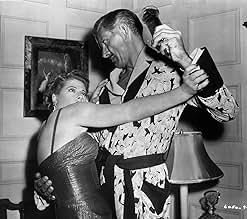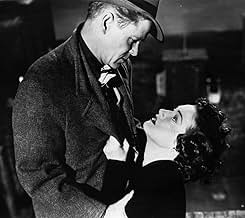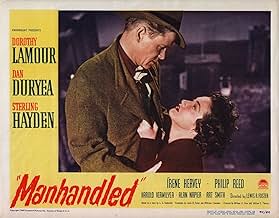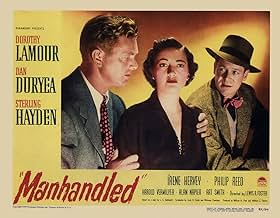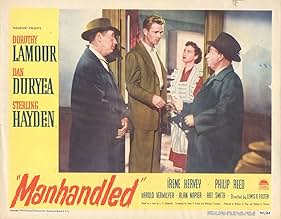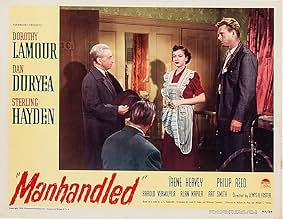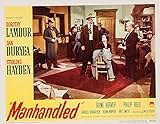IMDb-BEWERTUNG
6,5/10
991
IHRE BEWERTUNG
Füge eine Handlung in deiner Sprache hinzuThe secretary to a psychiatrist finds herself caught up in the murder of a patient's wife and realizes that her life is also in danger.The secretary to a psychiatrist finds herself caught up in the murder of a patient's wife and realizes that her life is also in danger.The secretary to a psychiatrist finds herself caught up in the murder of a patient's wife and realizes that her life is also in danger.
- Regie
- Drehbuch
- Hauptbesetzung
Benny Baker
- Boyd, Man in Apartment House Lobby with Girl
- (Nicht genannt)
Stanley Blystone
- Cop
- (Nicht genannt)
Paul E. Burns
- Pawn Shop Owner
- (Nicht genannt)
James Edwards
- Henry, Bennet's Butler
- (Nicht genannt)
Morgan Farley
- Doc, Police Lab Man
- (Nicht genannt)
John George
- Newspaper Vendor
- (Nicht genannt)
George Humbert
- Italian Restaurant Owner
- (Nicht genannt)
Ray Hyke
- Detective Phil Wilson
- (Nicht genannt)
Donald Kerr
- Reporter
- (Nicht genannt)
Empfohlene Bewertungen
... makes this film. Paramount made another film with the exact same name 25 years before, but it was a Gloria Swanson film very much of its time, and this is a film very much of its time - the film noir cycle. And the title is a bit bewildering since "manhandling" really has nothing to do with the plot.
The film opens with psychiatrist Dr. Redman listening to his patient, Alton Bennett (Alan Napier) , talking about a troubling recurring dream he has in which he murders his wealthy and wayward wife, Ruth (Irene Harvey). The doctor advises Bennett to sleep in the guest bedroom for a few nights if he is afraid of what he might do. He then tells his secretary, Merl (Dorothy Lamour), to return that night because he wants to tell Mrs. Bennett all about what her husband just said. Patient-doctor confidentiality isn't what it used to be apparently.
The most catching of Mrs. Bennett's possessions are a bunch of jewels that she owns that are worth and insured for one hundred thousand dollars. After the doctor tells Mrs. Bennett about her husband's dream, she blows it off basically telling the doctor that her husband is harmless. But the next day she is found murdered in her apartment and the jewels are missing.
There are plenty of suspects besides the husband. For one, the secretary Merl has some kind of secret past, and she has only been working for the doctor for four weeks. Her downstairs neighbor, a PI and ex-cop (Duryea) seems up to no good, and Ruth Bennett told her latest boyfriend about the husband's threat and he seems surprised and fascinated when she also tells him that the jewels are authentic - he thought they were fake. Who knows what other people Ruth might have told about the jewels or who these people that we know about might have told.
There are plenty of twists in this one, and who actually did it is a surprise, but it is a bit of a mystery that Duryea is third billed since he is the person you notice, whose character jumps off the screen at you. Lamour and even Sterling Hayden, whose big break will come the following year in Asphalt Jungle, and are both billed above Duryea, seem a bit two dimensional in this. It is really a plot driven noir.
Paramount didn't do very many noirs, but the ones they did do were done extremely well. Maybe this one isn't as well known as "Sorry Wrong Number" because there are no really big names in it. I'd recommend it.
The film opens with psychiatrist Dr. Redman listening to his patient, Alton Bennett (Alan Napier) , talking about a troubling recurring dream he has in which he murders his wealthy and wayward wife, Ruth (Irene Harvey). The doctor advises Bennett to sleep in the guest bedroom for a few nights if he is afraid of what he might do. He then tells his secretary, Merl (Dorothy Lamour), to return that night because he wants to tell Mrs. Bennett all about what her husband just said. Patient-doctor confidentiality isn't what it used to be apparently.
The most catching of Mrs. Bennett's possessions are a bunch of jewels that she owns that are worth and insured for one hundred thousand dollars. After the doctor tells Mrs. Bennett about her husband's dream, she blows it off basically telling the doctor that her husband is harmless. But the next day she is found murdered in her apartment and the jewels are missing.
There are plenty of suspects besides the husband. For one, the secretary Merl has some kind of secret past, and she has only been working for the doctor for four weeks. Her downstairs neighbor, a PI and ex-cop (Duryea) seems up to no good, and Ruth Bennett told her latest boyfriend about the husband's threat and he seems surprised and fascinated when she also tells him that the jewels are authentic - he thought they were fake. Who knows what other people Ruth might have told about the jewels or who these people that we know about might have told.
There are plenty of twists in this one, and who actually did it is a surprise, but it is a bit of a mystery that Duryea is third billed since he is the person you notice, whose character jumps off the screen at you. Lamour and even Sterling Hayden, whose big break will come the following year in Asphalt Jungle, and are both billed above Duryea, seem a bit two dimensional in this. It is really a plot driven noir.
Paramount didn't do very many noirs, but the ones they did do were done extremely well. Maybe this one isn't as well known as "Sorry Wrong Number" because there are no really big names in it. I'd recommend it.
The shot of an ecstatic Duryea running down a terrified Vermilyea in the narrow, darkened alley way is a great slice of noir. Too bad the tension comes so late because, despite the promising title and noir icon Duryea, the narrative holds together about as well as an O J Simpson alibi. Looks like three different scriptwriters came up with three different results, so you may need a chart to track all the threads meandering through the plot. What the screenplay lacks is focus. There really is no central character holding developments together. Hayden's the headliner, yet his role as insurance investigator remains oddly inessential. Instead, lowly Art Smith gets the law-and-order screen time and in fact most of the movie time. Now, I like actor Smith as much as the next guy, especially in sly roles (Ride the Pink Horse {1947}); still, his comic relief here is not only misplaced, but too often sounds like it's being done by the numbers. (And whoever is it that thought a cop car without brakes is funny!)
On a more positive note, Alan Napier gets a delicious turn as the snooty novelist husband, but unfortunately soon drops out of sight, and I'm really sorry Irene Hervey's sexy wife bites the dust early on. She's a lively and interesting presence, making her spats with Napier a movie high point. And that's another source of trouble. Everyone disappears from the narrative for significant periods, such that a nudge is sometimes needed to remember who they are, even the largely wasted Lamour. All this might be okay if the plot or direction generated some suspense, but they don't, at least in my little book. In fact, if it weren't for the great Duryea doing another of his patented oily operator roles, the movie would be much more forgettable than it already is. From the title, I certainly expected better.
On a more positive note, Alan Napier gets a delicious turn as the snooty novelist husband, but unfortunately soon drops out of sight, and I'm really sorry Irene Hervey's sexy wife bites the dust early on. She's a lively and interesting presence, making her spats with Napier a movie high point. And that's another source of trouble. Everyone disappears from the narrative for significant periods, such that a nudge is sometimes needed to remember who they are, even the largely wasted Lamour. All this might be okay if the plot or direction generated some suspense, but they don't, at least in my little book. In fact, if it weren't for the great Duryea doing another of his patented oily operator roles, the movie would be much more forgettable than it already is. From the title, I certainly expected better.
Despite Dorothy Lamour receiving star billing in "Manhandled", clearly the star of this one is Dan Duryea...a guy who really excelled at playing sleazy and malevolent characters. However, Lamour was a bigger stat at the time and Duryea mostly played strong supporting characters...so she got this billing. But for Lamour, there isn't much for her to do but be a victim...and hope that she isn't going to prison in this film.
When the story begins, a psychiatrist is having his secretary (Lamour) transcribe a very disturbed patient (Alan Napier) and his twisted fantasy of killing his wife. Well, pretty soon after this, the wife is murdered...and the rest of the film about the cops finding out the culprit. Karl Benson (Duryea) seems to be doing his best to frame her for the murder....but why?? And can the real story come out by the thrilling finale?
I loved a lot about this film but mostly what I loved was how gritty and nasty the film was...a great example of a noir classic. Duryea is at his best...so good you barely notice Sterling Hayden (a great noir actor)! See Duryea in the alleyway scene...where he plows a guy into a brick wall with his car! And, see Duryea slug Lamour's character...twice!! All in all, a nifty film...one that isn't particularly famous in the genre...but should be.
When the story begins, a psychiatrist is having his secretary (Lamour) transcribe a very disturbed patient (Alan Napier) and his twisted fantasy of killing his wife. Well, pretty soon after this, the wife is murdered...and the rest of the film about the cops finding out the culprit. Karl Benson (Duryea) seems to be doing his best to frame her for the murder....but why?? And can the real story come out by the thrilling finale?
I loved a lot about this film but mostly what I loved was how gritty and nasty the film was...a great example of a noir classic. Duryea is at his best...so good you barely notice Sterling Hayden (a great noir actor)! See Duryea in the alleyway scene...where he plows a guy into a brick wall with his car! And, see Duryea slug Lamour's character...twice!! All in all, a nifty film...one that isn't particularly famous in the genre...but should be.
"Manhandled" is a decent 1949 film with a terrific cast that could have been really excellent. Unfortunately, it suffers from a lack of focus from director Lewis Foster. Dorothy Lamour plays the secretary to a psychiatrist (Harold Vermilyea) who is treating an author (Alan Napier). The man has a recurring dream that he kills his wife (Irene Hervey) with a large perfume bottle. The doctor thinks he needs money and might be after his wife's jewels, worth somewhere in the range of $100,000.
Lamour, whose character's name is Merl Kramer, tells a detective in her apartment building (Dan Duryea) about the strange case. Any of us who have ever seen Dan Duryea in a film know that this is a mistake on her part. As could have been predicted, the wife of the author winds up dead, the jewels stolen, and one of the pieces winds up in Merl's couch. She pawns it and finds herself in deep trouble.
As you might be able to tell from the above description, the director isn't the only problem here. The script doesn't hold up to the most casual of scrutiny. Granted Merl doesn't tell the Duryea character the name of her boss' client, but she certainly would know what goes on in the office is confidential. The big perfume bottle as the murder weapon is pretty lame. The worst aspect for me is the diagnosis of the psychiatrist. A man and his wife are living under the same roof, but they're estranged. She's seeing somebody else, in fact, and the psychiatrist comes to the conclusion that the author wants his wife's jewels. That's some stretch.
It's always sad to see what happened to some of the glamorous female film stars - Lamour here is all of 34 and relegated to smaller films. Her character has a mysterious past which we never really learn about, another script hole. Sterling Hayden plays an insurance investigator and does a good job. Art Smith is the police detective and very funny.
Kind of a mish-mash, and a convoluted plot that could have emerged as a neat twist in other hands, but some good scenes nonetheless.
Lamour, whose character's name is Merl Kramer, tells a detective in her apartment building (Dan Duryea) about the strange case. Any of us who have ever seen Dan Duryea in a film know that this is a mistake on her part. As could have been predicted, the wife of the author winds up dead, the jewels stolen, and one of the pieces winds up in Merl's couch. She pawns it and finds herself in deep trouble.
As you might be able to tell from the above description, the director isn't the only problem here. The script doesn't hold up to the most casual of scrutiny. Granted Merl doesn't tell the Duryea character the name of her boss' client, but she certainly would know what goes on in the office is confidential. The big perfume bottle as the murder weapon is pretty lame. The worst aspect for me is the diagnosis of the psychiatrist. A man and his wife are living under the same roof, but they're estranged. She's seeing somebody else, in fact, and the psychiatrist comes to the conclusion that the author wants his wife's jewels. That's some stretch.
It's always sad to see what happened to some of the glamorous female film stars - Lamour here is all of 34 and relegated to smaller films. Her character has a mysterious past which we never really learn about, another script hole. Sterling Hayden plays an insurance investigator and does a good job. Art Smith is the police detective and very funny.
Kind of a mish-mash, and a convoluted plot that could have emerged as a neat twist in other hands, but some good scenes nonetheless.
Manhandled is directed by Lewis R. Foster and adapted to screenplay by Foster and Whitman Chambers from the novel "The Man Who Stole A Dream" written by L. S. Goldsmith. It stars Dorothy Lamour, Dan Duryea, Sterling Hayden, Irene Hervey and Art Smith. Music is by Darrell Calker and cinematography by Ernest Laszlo.
I'm going to kill you, Ruth. I have to.
Manhandled is one of those late 40s crime mysteries that feature film noir legends and film noir narrative tints, thus why it finds itself under the film noir banner. This is more a curse than a blessing. For it's not a particularly great film, where the presence of Hayden and Duryea - and Laszlo on photography - just about keeps things bubbling away to make it watchable till the end. It has been said that the narrative is too tricksy for its own good, yet that isn't apparent since the story is very easy to follow. The twists come and go at regular intervals, but always with narrative clarity.
The main thrust of the plot finds Lamour being set up as the killer of Mrs. Alton Bennet (Hervey), with Bennet's jewels the reason for the crime. But there are a few other candidates in the frame, all of which are written to be believable suspects. The cops investigating are waspish of tongue, with Smith as dry as the Sahara, and Hayden is playing an insurance investigator who is along for the ride doing exactly the same job that the coppers are doing!
Duryea is the star attraction, playing a homme fatale type who chews gum a lot, calls his girlfriend Kitten and clearly is as untrustworthy as it gets (classic Duryea portrayal really!). Hayden doesn't show up until half an hour in, but he's a welcome arrival even if he isn't given much to get his teeth into. While Lamour pouts and ponders whilst gaining sympathy, which ultimately makes us wish she had of done more film noir type films.
There's some nice metaphorical touches, such as Duryea encamped in his apartment watching a vermin species consistently running on its wheel, and Laszlo's photography goes up a notch in the latter half of film - Lamour's apartment becomes foreboding and all the hall staircase sequences take on a greater oppressive meaning. A dream sequence is chilling, and there's one particular violent scene that is unforgettable. Unfortunately some of the comedy, whilst funny at times (drugs scenes are chucklesome), takes the pic out of its dramatic comfort zone.
Hayden and Duryea fans are safe in the knowledge that this is one to see, but it still winds up as a wasted opportunity to be something far more tougher and poignant. 6/10
I'm going to kill you, Ruth. I have to.
Manhandled is one of those late 40s crime mysteries that feature film noir legends and film noir narrative tints, thus why it finds itself under the film noir banner. This is more a curse than a blessing. For it's not a particularly great film, where the presence of Hayden and Duryea - and Laszlo on photography - just about keeps things bubbling away to make it watchable till the end. It has been said that the narrative is too tricksy for its own good, yet that isn't apparent since the story is very easy to follow. The twists come and go at regular intervals, but always with narrative clarity.
The main thrust of the plot finds Lamour being set up as the killer of Mrs. Alton Bennet (Hervey), with Bennet's jewels the reason for the crime. But there are a few other candidates in the frame, all of which are written to be believable suspects. The cops investigating are waspish of tongue, with Smith as dry as the Sahara, and Hayden is playing an insurance investigator who is along for the ride doing exactly the same job that the coppers are doing!
Duryea is the star attraction, playing a homme fatale type who chews gum a lot, calls his girlfriend Kitten and clearly is as untrustworthy as it gets (classic Duryea portrayal really!). Hayden doesn't show up until half an hour in, but he's a welcome arrival even if he isn't given much to get his teeth into. While Lamour pouts and ponders whilst gaining sympathy, which ultimately makes us wish she had of done more film noir type films.
There's some nice metaphorical touches, such as Duryea encamped in his apartment watching a vermin species consistently running on its wheel, and Laszlo's photography goes up a notch in the latter half of film - Lamour's apartment becomes foreboding and all the hall staircase sequences take on a greater oppressive meaning. A dream sequence is chilling, and there's one particular violent scene that is unforgettable. Unfortunately some of the comedy, whilst funny at times (drugs scenes are chucklesome), takes the pic out of its dramatic comfort zone.
Hayden and Duryea fans are safe in the knowledge that this is one to see, but it still winds up as a wasted opportunity to be something far more tougher and poignant. 6/10
Wusstest du schon
- WissenswertesStar Dorothy Lamour, in her autobiography, described working with George Reeves in the role of "an extremely sinister cad," despite the fact that he is nowhere to be seen in the film and no studio or trade references confirm his participation.
- Zitate
Detective Lt. Bill Dawson: I've never known a congenital wise-guy yet that didn't outsmart himself.
- VerbindungenReferenced in Remington Steele: Cast in Steele (1984)
Top-Auswahl
Melde dich zum Bewerten an und greife auf die Watchlist für personalisierte Empfehlungen zu.
- How long is Manhandled?Powered by Alexa
Details
- Erscheinungsdatum
- Herkunftsland
- Sprache
- Auch bekannt als
- Manhandled
- Drehorte
- Produktionsfirma
- Weitere beteiligte Unternehmen bei IMDbPro anzeigen
- Laufzeit1 Stunde 37 Minuten
- Farbe
- Seitenverhältnis
- 1.37 : 1
Zu dieser Seite beitragen
Bearbeitung vorschlagen oder fehlenden Inhalt hinzufügen


